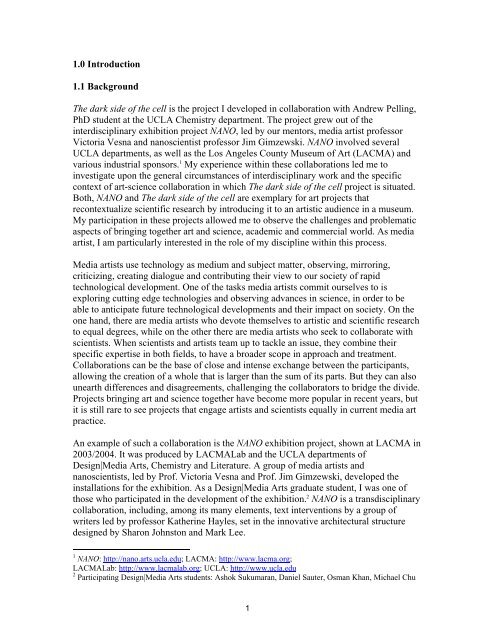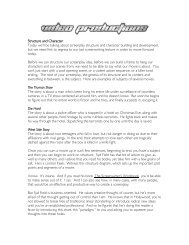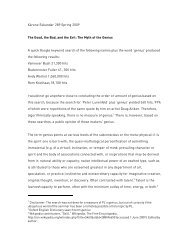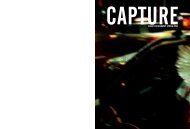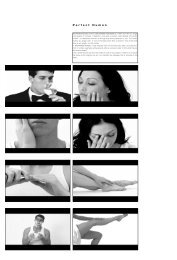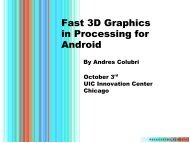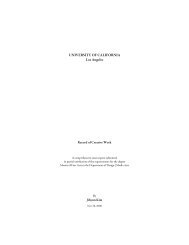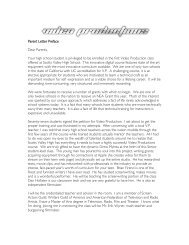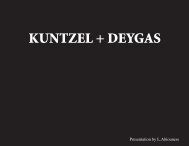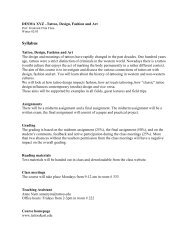Singing cells, art, science and the noise in between - Users - UCLA
Singing cells, art, science and the noise in between - Users - UCLA
Singing cells, art, science and the noise in between - Users - UCLA
Create successful ePaper yourself
Turn your PDF publications into a flip-book with our unique Google optimized e-Paper software.
1.0 Introduction<br />
1.1 Background<br />
The dark side of <strong>the</strong> cell is <strong>the</strong> project I developed <strong>in</strong> collaboration with Andrew Pell<strong>in</strong>g,<br />
PhD student at <strong>the</strong> <strong>UCLA</strong> Chemistry dep<strong>art</strong>ment. The project grew out of <strong>the</strong><br />
<strong>in</strong>terdiscipl<strong>in</strong>ary exhibition project NANO, led by our mentors, media <strong>art</strong>ist professor<br />
Victoria Vesna <strong>and</strong> nanoscientist professor Jim Gimzewski. NANO <strong>in</strong>volved several<br />
<strong>UCLA</strong> dep<strong>art</strong>ments, as well as <strong>the</strong> Los Angeles County Museum of Art (LACMA) <strong>and</strong><br />
various <strong>in</strong>dustrial sponsors. 1 My experience with<strong>in</strong> <strong>the</strong>se collaborations led me to<br />
<strong>in</strong>vestigate upon <strong>the</strong> general circumstances of <strong>in</strong>terdiscipl<strong>in</strong>ary work <strong>and</strong> <strong>the</strong> specific<br />
context of <strong>art</strong>-<strong>science</strong> collaboration <strong>in</strong> which The dark side of <strong>the</strong> cell project is situated.<br />
Both, NANO <strong>and</strong> The dark side of <strong>the</strong> cell are exemplary for <strong>art</strong> projects that<br />
recontextualize scientific research by <strong>in</strong>troduc<strong>in</strong>g it to an <strong>art</strong>istic audience <strong>in</strong> a museum.<br />
My p<strong>art</strong>icipation <strong>in</strong> <strong>the</strong>se projects allowed me to observe <strong>the</strong> challenges <strong>and</strong> problematic<br />
aspects of br<strong>in</strong>g<strong>in</strong>g toge<strong>the</strong>r <strong>art</strong> <strong>and</strong> <strong>science</strong>, academic <strong>and</strong> commercial world. As media<br />
<strong>art</strong>ist, I am p<strong>art</strong>icularly <strong>in</strong>terested <strong>in</strong> <strong>the</strong> role of my discipl<strong>in</strong>e with<strong>in</strong> this process.<br />
Media <strong>art</strong>ists use technology as medium <strong>and</strong> subject matter, observ<strong>in</strong>g, mirror<strong>in</strong>g,<br />
criticiz<strong>in</strong>g, creat<strong>in</strong>g dialogue <strong>and</strong> contribut<strong>in</strong>g <strong>the</strong>ir view to our society of rapid<br />
technological development. One of <strong>the</strong> tasks media <strong>art</strong>ists commit ourselves to is<br />
explor<strong>in</strong>g cutt<strong>in</strong>g edge technologies <strong>and</strong> observ<strong>in</strong>g advances <strong>in</strong> <strong>science</strong>, <strong>in</strong> order to be<br />
able to anticipate future technological developments <strong>and</strong> <strong>the</strong>ir impact on society. On <strong>the</strong><br />
one h<strong>and</strong>, <strong>the</strong>re are media <strong>art</strong>ists who devote <strong>the</strong>mselves to <strong>art</strong>istic <strong>and</strong> scientific research<br />
to equal degrees, while on <strong>the</strong> o<strong>the</strong>r <strong>the</strong>re are media <strong>art</strong>ists who seek to collaborate with<br />
scientists. When scientists <strong>and</strong> <strong>art</strong>ists team up to tackle an issue, <strong>the</strong>y comb<strong>in</strong>e <strong>the</strong>ir<br />
specific expertise <strong>in</strong> both fields, to have a broader scope <strong>in</strong> approach <strong>and</strong> treatment.<br />
Collaborations can be <strong>the</strong> base of close <strong>and</strong> <strong>in</strong>tense exchange <strong>between</strong> <strong>the</strong> p<strong>art</strong>icipants,<br />
allow<strong>in</strong>g <strong>the</strong> creation of a whole that is larger than <strong>the</strong> sum of its p<strong>art</strong>s. But <strong>the</strong>y can also<br />
une<strong>art</strong>h differences <strong>and</strong> disagreements, challeng<strong>in</strong>g <strong>the</strong> collaborators to bridge <strong>the</strong> divide.<br />
Projects br<strong>in</strong>g<strong>in</strong>g <strong>art</strong> <strong>and</strong> <strong>science</strong> toge<strong>the</strong>r have become more popular <strong>in</strong> recent years, but<br />
it is still rare to see projects that engage <strong>art</strong>ists <strong>and</strong> scientists equally <strong>in</strong> current media <strong>art</strong><br />
practice.<br />
An example of such a collaboration is <strong>the</strong> NANO exhibition project, shown at LACMA <strong>in</strong><br />
2003/2004. It was produced by LACMALab <strong>and</strong> <strong>the</strong> <strong>UCLA</strong> dep<strong>art</strong>ments of<br />
Design|Media Arts, Chemistry <strong>and</strong> Literature. A group of media <strong>art</strong>ists <strong>and</strong><br />
nanoscientists, led by Prof. Victoria Vesna <strong>and</strong> Prof. Jim Gimzewski, developed <strong>the</strong><br />
<strong>in</strong>stallations for <strong>the</strong> exhibition. As a Design|Media Arts graduate student, I was one of<br />
those who p<strong>art</strong>icipated <strong>in</strong> <strong>the</strong> development of <strong>the</strong> exhibition. 2 NANO is a transdiscipl<strong>in</strong>ary<br />
collaboration, <strong>in</strong>clud<strong>in</strong>g, among its many elements, text <strong>in</strong>terventions by a group of<br />
writers led by professor Ka<strong>the</strong>r<strong>in</strong>e Hayles, set <strong>in</strong> <strong>the</strong> <strong>in</strong>novative architectural structure<br />
designed by Sharon Johnston <strong>and</strong> Mark Lee.<br />
1 NANO: http://nano.<strong>art</strong>s.ucla.edu; LACMA: http://www.lacma.org;<br />
LACMALab: http://www.lacmalab.org; <strong>UCLA</strong>: http://www.ucla.edu<br />
2 P<strong>art</strong>icipat<strong>in</strong>g Design|Media Arts students: Ashok Sukumaran, Daniel Sauter, Osman Khan, Michael Chu<br />
1


